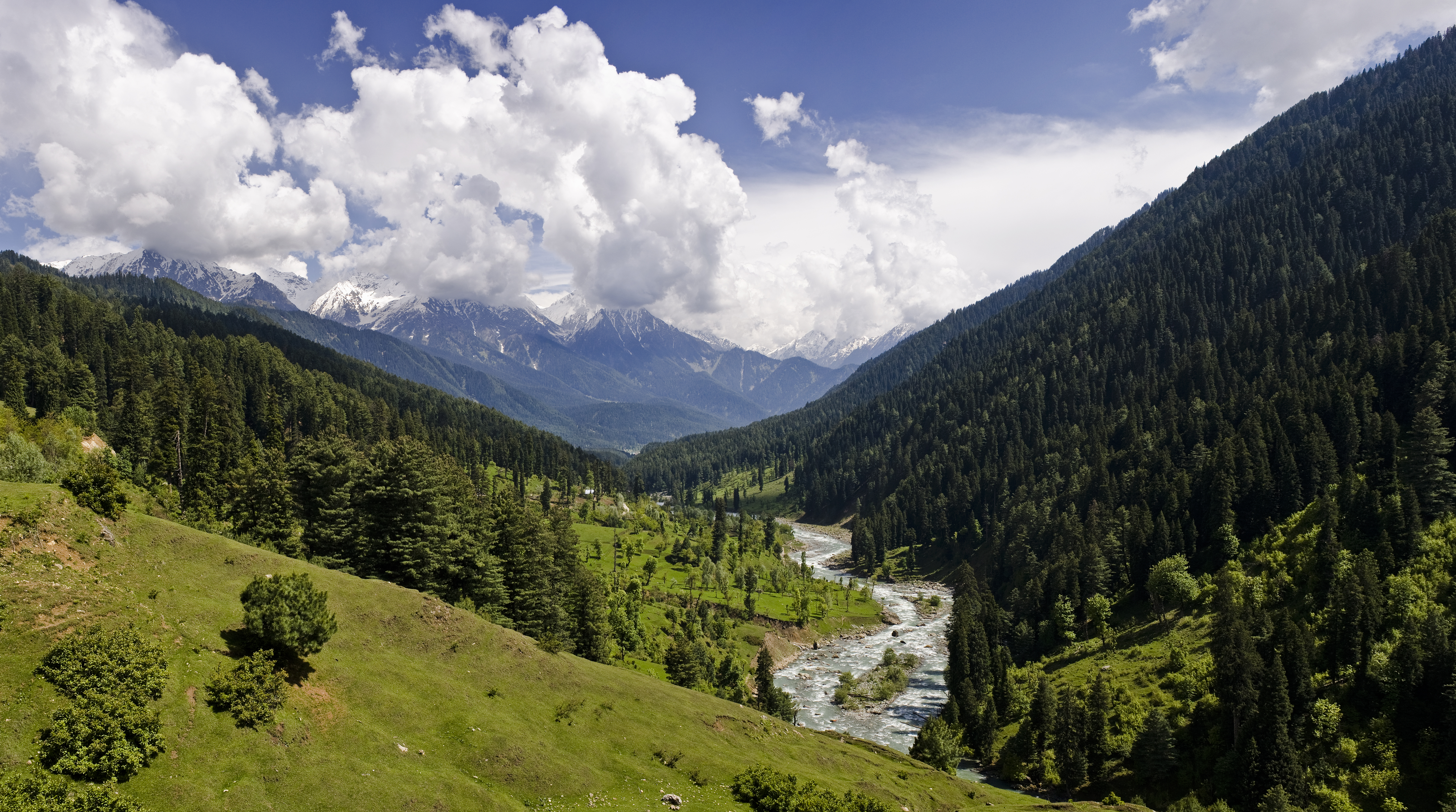|
India–Pakistan Border
The Indo–Pak border or India-Pakistan border is the international boundary that separates India and Pakistan. At its northern end is the Line of Control, which separates Indian-administered Kashmir from Pakistani-administered Kashmir; and at its southern end is Sir Creek, a tidal estuary in the Rann of Kutch between the Indian state of Gujarat and the Pakistani province of Sindh. Originally demarcated on the basis of the Radcliffe Line during the partition of British India in 1947, the border traverses a variety of terrain ranging from major urban areas to inhospitable deserts. Since the beginning of the India–Pakistan conflict shortly after the two countries' conjoined independence, it has been the site of numerous cross-border military standoffs and full-scale wars. The border's total length is according to figures given by the PBS; it is also ranked as one of the most dangerous international boundaries in the world, based on an article written in ''Foreign Policy'' ... [...More Info...] [...Related Items...] OR: [Wikipedia] [Google] [Baidu] |
Outer Space
Outer space, commonly shortened to space, is the expanse that exists beyond Earth and its atmosphere and between celestial bodies. Outer space is not completely empty—it is a near-perfect vacuum containing a low density of particles, predominantly a plasma of hydrogen and helium, as well as electromagnetic radiation, magnetic fields, neutrinos, dust, and cosmic rays. The baseline temperature of outer space, as set by the background radiation from the Big Bang, is . The plasma between galaxies is thought to account for about half of the baryonic (ordinary) matter in the universe, having a number density of less than one hydrogen atom per cubic metre and a kinetic temperature of millions of kelvins. Local concentrations of matter have condensed into stars and galaxies. Studies indicate that 90% of the mass in most galaxies is in an unknown form, called dark matter, which interacts with other matter through gravitational but not electromagnetic forces. Observations ... [...More Info...] [...Related Items...] OR: [Wikipedia] [Google] [Baidu] |
Rann Of Kutch
The Rann of Kutch (alternately spelled as Kuchchh) is a large area of salt marshes that span the border between India and Pakistan. It is located in Gujarat (primarily the Kutch district), India, and in Sindh, Pakistan. It is divided into the Great Rann and Little Rann. Geography The Rann of Kutch is located mostly in the Indian state of Gujarat, specifically Kutch district, for which it is named. Some parts extend into the Pakistani province of Sindh. The word ''Rann'' means "desert". The Rann of Kutch covers around 26,000 square kilometres (10,000 square miles). The Great Rann of Kutch is the larger portion of the Rann. It extends east and west, with the Thar Desert to the north and the low hills of Kutch to the south. The Indus River Delta lies to the west in southern Pakistan. The Little Rann of Kutch lies southeast of the Great Rann, and extends southwards to the Gulf of Kutch. Many rivers originating in Rajasthan and Gujarat flow into the Rann of Kutch, includ ... [...More Info...] [...Related Items...] OR: [Wikipedia] [Google] [Baidu] |
Attari
Attari, also spelled Atari, is a village of Amritsar district in the Punjab state of India, 3 km from the Indo-Pakistani border at Wagah. It is situated 25 km west of the Sikh holy city of Amritsar, and is the last Indian station on the rail route connecting Lahore, Pakistan with the Indian capital Delhi. Attari village was the native village of Sardar Sham Singh Attariwala, one of the generals in the Army of Maharaja Ranjit Singh. History Attari village, in the Majha Region, was founded by two Sidhu Jat brothers, by the name of Gaur Singh and Kaur Singh around 1740. They were the sons of Chaudhri Kahn Chand Sidhu of village Kaonke in Ludhiana (Malwa). The two brothers immigrated to the Majha Region beyond the Sutlej River. Firstly the found another village, by the name of Kaunke (Amtitsar). Later a famous local ascetic named Mool Dass pointed the brothers towards a large mound ("theh" in Punjabi), and asked them to establish a new village. Gaura got built a attari ... [...More Info...] [...Related Items...] OR: [Wikipedia] [Google] [Baidu] |
British Empire
The British Empire was composed of the dominions, colonies, protectorates, mandates, and other territories ruled or administered by the United Kingdom and its predecessor states. It began with the overseas possessions and trading posts established by England between the late 16th and early 18th centuries. At its height it was the largest empire in history and, for over a century, was the foremost global power. By 1913, the British Empire held sway over 412 million people, of the world population at the time, and by 1920, it covered , of the Earth's total land area. As a result, its constitutional, legal, linguistic, and cultural legacy is widespread. At the peak of its power, it was described as " the empire on which the sun never sets", as the Sun was always shining on at least one of its territories. During the Age of Discovery in the 15th and 16th centuries, Portugal and Spain pioneered European exploration of the globe, and in the process established ... [...More Info...] [...Related Items...] OR: [Wikipedia] [Google] [Baidu] |
Jammu And Kashmir (union Territory)
Jammu and Kashmir is a region administered by India as a union territory and consists of the southern portion of the larger Kashmir region, which has been the subject of a dispute between India and Pakistan since 1947, and between India and China since 1962.(a) (subscription required) Quote: "Kashmir, region of the northwestern Indian subcontinent ... has been the subject of dispute between India and Pakistan since the partition of the Indian subcontinent in 1947. The northern and western portions are administered by Pakistan and comprise three areas: Azad Kashmir, Gilgit, and Baltistan, the last two being part of a territory called the Northern Areas. Administered by India are the southern and southeastern portions, which constitute the state of Jammu and Kashmir but are slated to be split into two union territories. China became active in the eastern area of Kashmir in the 1950s and has controlled the northeastern part of Ladakh (the easternmost portion of the region) sinc ... [...More Info...] [...Related Items...] OR: [Wikipedia] [Google] [Baidu] |
Punjab, Pakistan
Punjab (; , ) is one of the four provinces of Pakistan. Located in central-eastern region of the country, Punjab is the second-largest province of Pakistan by land area and the largest province by population. It shares land borders with the Pakistani provinces of Khyber Pakhtunkhwa to the north-west, Balochistan to the south-west and Sindh to the south, as well as Islamabad Capital Territory to the north-west and Autonomous Territory of AJK to the north. It shares an International border with the Indian states of Rajasthan and Punjab to the east and Indian-administered Kashmir to the north-east. Punjab is the most fertile province of the country as River Indus and its four major tributaries Ravi, Jhelum, Chenab and Sutlej flow through it. The province forms the bulk of the transnational Punjab region, now divided among Pakistan and India. The provincial capital is Lahore — a cultural, modern, historical, economic, and cosmopolitan centre of Pakistan. Other major ci ... [...More Info...] [...Related Items...] OR: [Wikipedia] [Google] [Baidu] |
Indo-Pakistani War Of 1971
The Indo-Pakistani War of 1971 was a military confrontation between India and Pakistan that occurred during the Bangladesh Liberation War in East Pakistan from 3 December 1971 until the Pakistani capitulation in Dhaka on 16 December 1971. The war began with Pakistan's Operation Chengiz Khan, consisting of preemptive aerial strikes on 11 Indian air stations. The strikes led to India declaring war on Pakistan, marking their entry into the war for East Pakistan's independence, on the side of Bengali nationalist forces. India's entry expanded the existing conflict with Indian and Pakistani forces engaging on both the eastern and western fronts. Thirteen days after the war started, India achieved a clear upper hand, and the Eastern Command of the Pakistan military signed the instrument of surrender on 16 December 1971 in Dhaka, marking the formation of East Pakistan as the new nation of Bangladesh. Approximately 93,000 Pakistani servicemen were taken prisoner ... [...More Info...] [...Related Items...] OR: [Wikipedia] [Google] [Baidu] |
Pakistan-administered Kashmir
Kashmir () is the northernmost geographical region of the Indian subcontinent. Until the mid-19th century, the term "Kashmir" denoted only the Kashmir Valley between the Great Himalayas and the Pir Panjal Range. Today, the term encompasses a larger area that includes the Indian-administered territories of Jammu and Kashmir and Ladakh, the Pakistani-administered territories of Azad Kashmir and Gilgit-Baltistan, and the Chinese-administered territories of Aksai Chin and the Trans-Karakoram Tract. Quote: "Kashmir, region of the northwestern Indian subcontinent. It is bounded by the Uygur Autonomous Region of Xinjiang to the northeast and the Tibet Autonomous Region to the east (both parts of China), by the Indian states of Himachal Pradesh and Punjab to the south, by Pakistan to the west, and by Afghanistan to the northwest. The northern and western portions are administered by Pakistan and comprise three areas: Azad Kashmir, Gilgit, and Baltistan, ... The southern and south ... [...More Info...] [...Related Items...] OR: [Wikipedia] [Google] [Baidu] |
Kashmir Region (working Boundary)
Kashmir () is the northernmost geographical region of the Indian subcontinent. Until the mid-19th century, the term "Kashmir" denoted only the Kashmir Valley between the Great Himalayas and the Pir Panjal Range. Today, the term encompasses a larger area that includes the Indian-administered territories of Jammu and Kashmir and Ladakh, the Pakistani-administered territories of Azad Kashmir and Gilgit-Baltistan, and the Chinese-administered territories of Aksai Chin and the Trans-Karakoram Tract. Quote: "Kashmir, region of the northwestern Indian subcontinent. It is bounded by the Uygur Autonomous Region of Xinjiang to the northeast and the Tibet Autonomous Region to the east (both parts of China), by the Indian states of Himachal Pradesh and Punjab to the south, by Pakistan to the west, and by Afghanistan to the northwest. The northern and western portions are administered by Pakistan and comprise three areas: Azad Kashmir, Gilgit, and Baltistan, ... The southern and southe ... [...More Info...] [...Related Items...] OR: [Wikipedia] [Google] [Baidu] |
Floodlight
A floodlight is a broad-beamed, high-intensity artificial light. They are often used to illuminate outdoor playing fields while an outdoor sports event is being held during low-light conditions. More focused kinds are often used as a stage lighting instrument in live performances such as concerts and plays. In the top tiers of many professional sports, it is a requirement for stadiums to have floodlights to allow games to be scheduled outside daylight hours. Evening or night matches may suit spectators who have work or other commitments earlier in the day, and enable television broadcasts during lucrative primetime hours. Some sports grounds which do not have permanent floodlights installed may make use of portable temporary ones instead. Many larger floodlights (see bottom picture) will have gantries for bulb changing and maintenance. These will usually be able to accommodate one or two maintenance workers. Types The most common type of floodlight is the metal-halid ... [...More Info...] [...Related Items...] OR: [Wikipedia] [Google] [Baidu] |
Foreign Policy
A state's foreign policy or external policy (as opposed to internal or domestic policy) is its objectives and activities in relation to its interactions with other states, unions, and other political entities, whether bilaterally or through multilateral platforms.Foreign policy ''Encyclopedia Britannica'' (published January 30, 2020). The '' Encyclopedia Britannica'' notes that a government's foreign policy may be influenced by "domestic considerations, the policies or behaviour of other states, or plans to advance specific geopolitical designs." History The idea of long-term management of relationships followed the development of professional |
.jpg)







